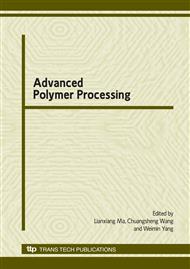p.98
p.104
p.110
p.116
p.119
p.125
p.130
p.134
p.137
Influences of Preparative Conditions on Properties of Erythromycin-Molecularly Imprinted Membrane
Abstract:
Erythromycin molecularly imprinted membranes (EM-MIMs) were prepared by wet phase inversion from imprinted polymers which were prepared by MAA as functional monomer, AN as membrane monomer and EDMA as crosslinker in the presence of erythromycin as template. The influences of the proportion of EM and MAA, cross-linking use level, different initiators and use level as well as extraction time on the imprinted sites and specific separation of EM-MIMs for EM were investigated. The results show that EM-MIMs were provided with more imprinted sites and more excellent separation properties for EM when adding MAA 0.0461mol, EM 0.724mmol, AIBN and (NH4)2S2O8 each 0.12g as initiators, and the mole ratio of EDMA and MAA at 5:1. The extraction of templates was carried out by using absolute ethyl alcohol as eluant and ultrasonic oscillating for 40min.
Info:
Periodical:
Pages:
119-124
Citation:
Online since:
December 2009
Authors:
Keywords:
Price:
Сopyright:
© 2010 Trans Tech Publications Ltd. All Rights Reserved
Share:
Citation:


